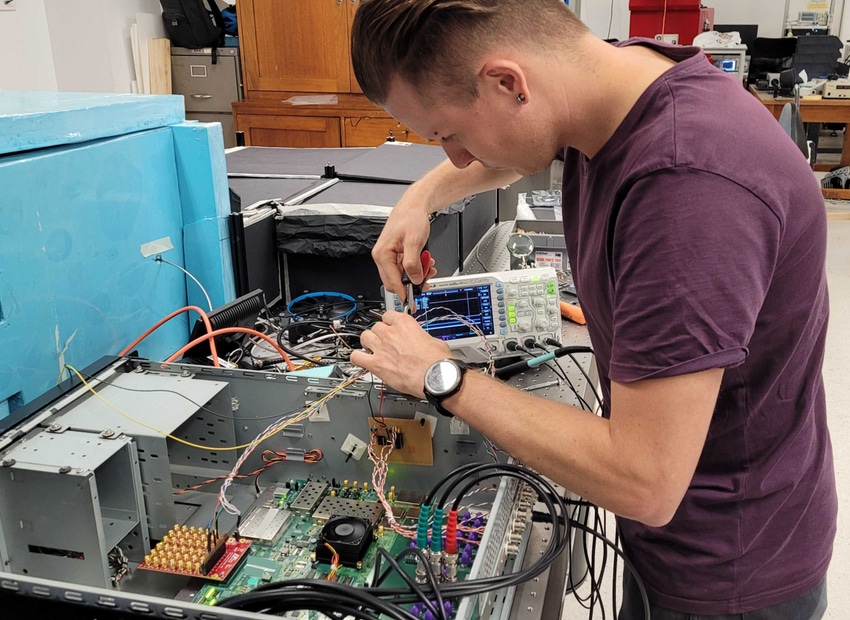
Connects decision-makers and solutions creators to what's next in quantum computing
Diamond-based quantum computers expected to be much smaller

In a move aiming toward desktop-sized quantum computers, a quantum computing company is expanding its university partnership from two in Germany by adding two more in Australia.
The Australia research and development partnership with La Trobe University and RMIT University aims to develop an industrial process to increase both the yield and precision of diamond quantum processor fabrication.
The company, Quantum Brilliance, already has a similar hub in Germany with the Fraunhofer Institute and Ulm University.
“These two hubs combined are the world's best to resolve these issues and take this from a basic research level to a technique that can be implemented to scale the number of qubits and ultimately scale up to manufacturing,” said Marcus Doherty, Quantum Brilliance co-founder and chief scientific officer.
Quantum computers tend to be the size of a wardrobe and many types of quantum processors require a room full of refrigerating machinery since they can only operate at temperatures close to absolute zero.
Diamond-based quantum computers held early promise of delivering solutions that could be much smaller and operate at room temperature, but they proved difficult to scale.
The Quantum Brilliance university partnership intends to improve the process for fabricating diamond quantum processors that could lead to more powerful room-temperature, desktop-sized quantum computers.
Diamond quantum computers rely on synthesizing diamonds with a carbon atom precisely swapped out for a nitrogen atom. This “impurity” generates qubits, the processing unit of quantum computing, and is known as nitrogen-vacancy (NV) technology.
The German-Australian company is now working with the Australian universities to scale the diamond quantum processor fabrication process.
The aims are twofold, according to Doherty: to create precise arrays of diamond qubits in bulk and to miniaturize diamond quantum computers first to the size of a desktop and then eventually to the size of a standard central processing unit (CPU) or graphics processing unit (GPU), about the size of a lunchbox.
“Our vision is that in five years, we will have 50 qubits in a device that is the same size as a modern GPU or CPU but that can outperform a GPU or CPU in certain tasks, such as image or signal processing, optimization or chemical simulation,” said Doherty.
“This leads to a very different future, where quantum computing is deployed everywhere that CPUs and GPUs are deployed, such as in satellites doing Earth observation, a variety of defense applications, autonomous vehicles, robotics and medical imaging suites.”
These compact quantum processing units (QPUs) are going to be massively parallelized into a new generation of supercomputers, much like current supercomputers contain thousands of CPUs and GPUs, according to Doherty.
“Importantly, they will complement the mainframe quantum computers being developed by other companies,” he said. “By having a quantum computer with thousands of QPUs, you can access many more diverse use cases and solve different problems to what mainframe quantum computers focus on.”
Quantum Brilliance’s current desktop-size quantum computer offers two qubits of processing power, and the company plans to install one at the Pawsey supercomputing center in Western Australia in the coming weeks. It will be the first time a small form-factor, room-temperature quantum computer has been installed in a supercomputer center.
As well as working towards 50-qubit diamond quantum computers over the next five years, Quantum Brilliance is looking to work with more strategic customers to do platform integration with classical computing systems. It also plans to partner on use cases, installing its quantum computers into satellites, robots and autonomous vehicles.
While Doherty is an enthusiastic evangelist for diamond quantum computing, he recognizes that it won’t exist in a vacuum and will complement other forms of computing.
“The current zeitgeist is the idea of this gigantic quantum supercomputer and now there's a very different version of quantum computer that will be complementary and will have the same if not more use cases, because of its ability to be deployed and to act in different ways,” he said.
“I’d encourage people to think about what it would mean to employ this different version of quantum that is accessible to everybody. Once, the idea of connecting to one or a few quantum supercomputers was a barrier and might have led people to dismiss quantum computing as irrelevant.”
About the Author(s)
You May Also Like
.png?width=100&auto=webp&quality=80&disable=upscale)
.png?width=400&auto=webp&quality=80&disable=upscale)




